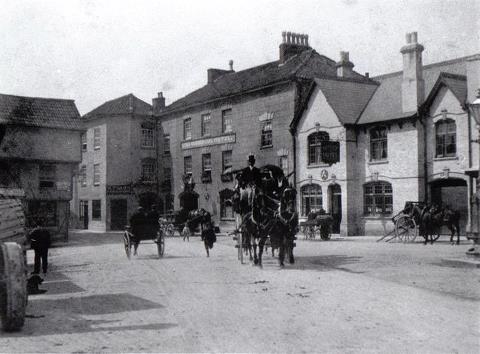

What was it like to visit the Strawberry Line in 1899? Using an 1899 guidebook Harry Mottram took a trip from Clevedon to Wells in a tweed Norfolk suit in search of Victorian Somerset.
Cyclists should dismount when descending Cheddar Gorge and Clevedon is not condusive to bathing but does have smart shops. These and other useful tops help to make up an 1899 copy of Black’s Guide Book sold for one shilling in Winscombe’s stationer of the same era. Edited by A R Hope Moncrieff the author notes in his preface that as may be expected in a pocket guide to the British Isles that “everything has not been said that might be said; but so far as our limits allow, we have tried to point out to strangers what is best worth seeing in this most attractive corner of England.” And so with guide in hand having first put on a very stiff and itchy Norfolk suit I set off in search of Victorian Somerset travelling from Clevedon to Wells – by bicycle. Traffic excepted and also the considerably greater number of houses built in the last 113 years there are surprisingly many things that haven’t changed a jot.
Judge for yourself with these notes:
Clevedon: “This town straggles roomily on and beneath heights overlooking the Bristol Channel, and has an agreeably informal aspect in its winding lines of villas and open terraces. To the right for the Pier, the smart shops, and the cliff quarter known as Walton, the Bristol end, where a sea walk leads along the edge to a nook called Ladye Bay.” It’s a description that wouldn’t be incorrect today of the town that’s “sheltered from cold winds by the bank of Dial Hill”. However the guide warns that bathing is not tempting due to the beach not being “very salt or sea-like,” but recommends Ladye Bay where “a good swim can be had when the tide is up.”
Yatton: “A thriving-like village, just outside of which on the east side stands a solid tower, capped by the uncommon feature of a truncate spire, marking the church, which contains a fine altar tomb and other monuments of the Newton Family.” Sadly there’s no record of the shops, blacksmith or pubs in the guide although it suggests a walk to Weston – now nicknamed Weston-super-Mare – because it’s a pretty town and quite lively. Presumably due to the vast numbers of Welsh miners who descended on the resort by paddle steamer and the day trippers from Bristol’s growing suburbs in search of fun and frolics on their high days and holidays.

Congresbury: “A village graced with a fine church with a pleasant walk to wooded Wrington just four miles away.” The guide notes Congresbury is pronounced “Coomsbury.” The walk to Wrington warns of a ruined mill and a circuitous route along a river bank in order to approach the little town of 1,500 people noted for its connections with John Locke and Hannah More. It describes a path to Goblin Combe via The Golden Lion pub to “the savage glen, edged by Limestone cliffs and banks of screes.”

Winscombe: For some reason the author glosses over Banwell and Sanford and arrives by train in Winscombe – no longer called Woodborough – which he describes as a scattered village. Like all good Victorians he heads to the church “with its fine yew” and “fine outlook”. He quickly embarks by trains for Axbridge through the tunnel from whence “we glimpse Brent Knoll; to the south swells the broken ground of Wedmore, and beyond an isolated hillock is seen the tower of Glastonbury Tor.”
Axbridge: “One the chief towns still having such dignity as petty sessions, a workhouse, and two banks can give but only 700 inhabitants.” He notes the “quaint old houses and stately church,” and claims to see the River Axe “below on the plain”.

Cheddar: “The station is about a mile from the entrance of the gorge, for which conveyances (4d) are usually in waiting. The Cliff Hotel, near the foot of the gorge is the goal of driving excursions.” The guide is clearly taken with Cheddar as it affords more space than anywhere else in the pocket book – even than Wells. It describes the fierce rivalry between the owners of both main caves, Gough’s and Cox’s – both charging 2/- entrance fee and both lit up to display their “stalactite wonders” for the “patronage of pilgrims.” We also get considerable description of the gorge and the surrounding country which clearly was the big draw for visitors seeking something of a lost wilderness that once covered England from end to end. He cautions cyclists to dismount once they arrive at the end of the wooded part of the top end of the gorge due to “not knowing what may be around each corner.” Something that some motorists should pay heed to today.

Wedmore: Our guide instructs us to take a short four mile walk across the pastures to Wedmore, a village of 3,000 people with its “rambles pleasant by contrast to the environing flats.”
Wells: “A city of under 5,000 inhabitants, wears a look of quiet diginity.” He describes the Town hall and Council Chambers with its exhibition of portraits, the two stations within easy reach of the cathedral and reiterates the truism that nowhere is a city with so many buildings still being used for their original purpose.

For more reviews, news and views on theatre and much else visit www.harrymottram.co.uk
Follow Harry on Facebook, Twitter as @harrythespiv, Instagram, YouTube and LinkedIn


You must be logged in to post a comment.